Let’s have a chat about all the wonderful ways that Microsoft SharePoint benefits your business. With the vast array of business-related productivity tools and software packages, it frequently feels like there’s too much to choose from. If your business is already running several tools and platforms, the prospect of adding another (or migrating to a new one) can be exhausting. In business, we often work with the default tool we are exposed to. This tool, though, is often not the best for the job.
With that in mind, Microsoft SharePoint is an excellent business tool that seems to fly under a lot of radars. Previously accessible only to larger enterprises, Microsoft has worked to make SharePoint more accessible and simplified for every size business. So bearing all this in mind, let’s deep dive into SharePoint in 2020.
What is SharePoint?
Ultimately, it’s a platform. If you need a way simplify to your document sharing and collaboration, then SharePoint is the tool you need. Share files and documents within your team or organisation without needing to keep track of the latest version.
It’s a cloud-based server for all your internal resources and files that anyone within your organisation could need. Consider it as an internal directory containing all the information you could need to perform any task or project within your business. And if it doesn’t exist, you can create it.
As a part of the Office 365 suite, SharePoint naturally integrates with other Microsoft Apps. This especially applies to Microsoft Teams. Teams and SharePoint work hand-in-hand to make your collaborative projects significantly simpler and easier (but we can delve more into that later).
It works by creating a secure site that can be used to store, share, access and organise information. This site is your team’s private directory for hosting all documentation relevant to that team or project. It greatly simplifies the collaboration process.
SharePoint vs OneDrive
This has possibly led you to wonder, what’s the difference between a tool like Microsoft SharePoint, and OneDrive? At a glance, SharePoint vs OneDrive seems like they both perform the same role.
There is some definite overlap between the two products. First and foremost is the basic ability to store files and share them with team members. However, there are some key differences. Let’s compare the two:
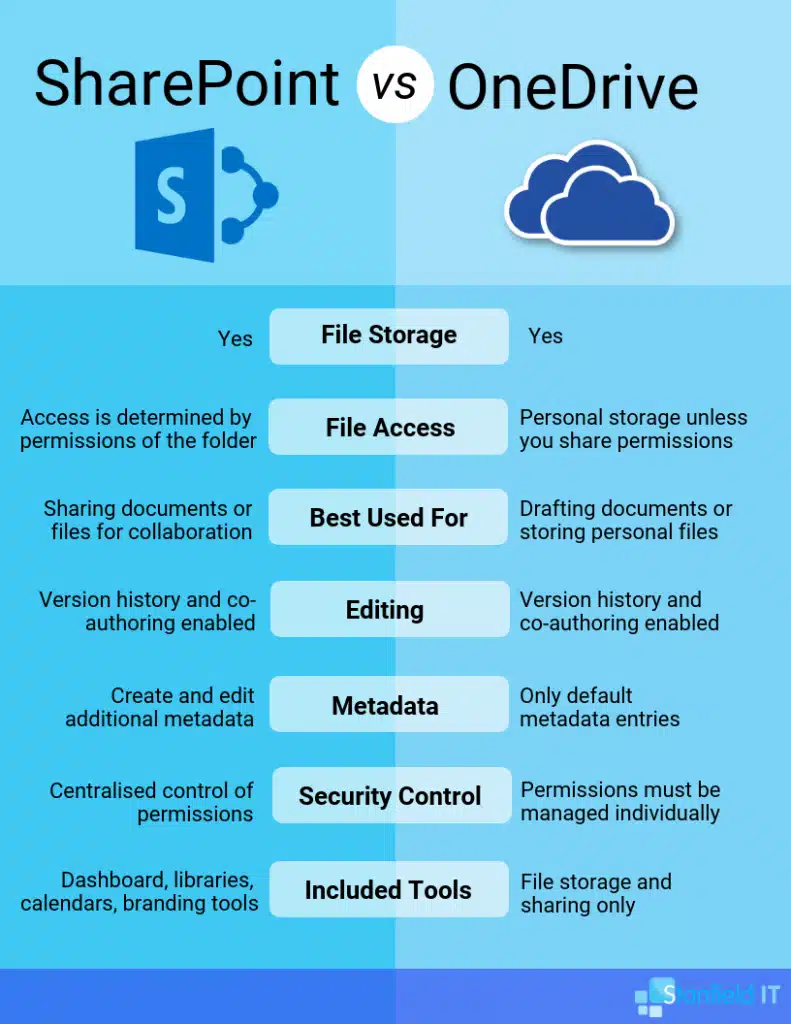
To try and summarise the difference: SharePoint focuses on sharing files within a group or team capacity (with the ability for all invited members to edit those files) and OneDrive is more of a personal storage facility, much like having ‘My Documents’ on the cloud.
The 8 Best SharePoint Benefits For Business
So far, we have covered a very simplified overview of what SharePoint is. But how about digging into what SharePoint can really do for your business. What are the SharePoint benefits to you? What are SharePoint lists? Is SharePoint a database? What makes it such a special product? Firstly, SharePoint stands out for being not just a singular ‘product’ per se.
It’s a centralised system for managing information and team work. That sounds like some really scripted marketing jargon, but Microsoft SharePoint is truly more than just a storage hub and it has so many components that it becomes difficult to simplify without using such marketing-sounding-descriptions.
So let’s have a look at the individual features that make up Microsoft SharePoint, and what’s so great about them. We want to give you the best possible insight into this tool, so you can make an educated decision about whether it is what you need for your organisation. In no particular order, here are some of our favourite features of SharePoint:
1. Alerts
Create automated, customised alerts to notify you when changes are made to a certain file or library within SharePoint. Keep track of any changes or deletions to files that matter to you and make sure you don’t miss anything important. These alerts come to you as email notifications and you can choose if you want them as an immediate notice, or daily/weekly summary.
As an example, instead of constantly checking in with that report you wrote, just wait for an alert to advise you when your boss has reviewed it. You can also subscribe other team members to alerts to keep them apprised of any ongoing changes and status updates.
2. Dashboards
SharePoint dashboards are an excellent way to keep track of your document progress, project updates, and KPIs. It’s a simplified way to communicate status updates across the board, in a clear way and at a glance. Representing this core data in one place means it’s easier to stay on track with your targets, as you monitor your ongoing progress.
Employees can see where they’re at, with regards to where they need to be, and as a result have more motivation to keep pushing. It’s also a simple way for any associated supervisor to check in on the progress of any reports or projects.
3. Content Management
A central function of SharePoint is its ability to explore, manage and create content. So, while this is one of the core functions at the heart of it, it’s also an excellent feature due to the way it performs this function in comparison to other similarly-marketed tools.
It’s not enough to just have a dumping ground for all your files and documents. A content management system needs to effectively organise and manage your files as well. Even within the context of a small business, simply having a shared network for file management can get messy very quickly with duplicate files, and inconsistent storage locations. SharePoint enables you to manage who has access to read, write and delete files and with document version history, you can easily follow information about when a file was changed and by whom.
4. Lists
You’re probably wondering what are SharePoint lists? Lists are like spreadsheets contained within SharePoint. They are another effective way to manage information. SharePoint Lists are accessible to multiple users simultaneously for collaborative work. Lists can include people, links, pictures, dates and more. You can even track the history of a list item with versions.
While a SharePoint list works very much like an Excel spreadsheet, there is a key difference. If an Excel sheet is saved within SharePoint, it’s highly likely that there are still multiple versions of that document floating around your organisation as each user saves a copy on their local machine and edits it. Suddenly you have different versions that don’t match. Keeping your spreadsheet as a SharePoint list means that it’s always up to date and always the correct version.
5. Usage Reports
We touched on Dashboards above as a way to keep an eye on KPIs and file activity. However, Microsoft SharePoint goes a bit deeper than that, if you choose to use it that way. The SharePoint site owner is able to view information about how users are interacting with the site. You can view how many people have visited the site, how many times users have visited the site, and which files have the most views. This data is presented in a neat, and simple graph; easy to view at a glance.
You can get into even more detail as a SharePoint admin. You can monitor app usage, and error information. Customise a list of which apps you want to keep track of. Then use this function to view details such as the number of licences purchased or used, a summary of errors and installations and usage information.
6. Workflows
Here’s another excellent tool for managing your work within SharePoint. What is a workflow? It’s much like a flowchart for your document flow process with a huge exception. It actually enforces the process for you. The old way requires you and Karen and Bill to have a whole lot of back and forth to review and approve and update, and remind Bill again that he never sent his approval, and so on (chances are you’ve been in this exact situation before if you’ve ever had to deal with any office bureaucracy).
The SharePoint way means that the workflow automatically checks and tracks and forwards documents for you. If someone is late, or hasn’t otherwise completed their part of the flow, SharePoint will generate a notification to nudge them. The Workflow can be designed to collect feedback, approval, signatures or even just publishing approval.
7. Libraries
SharePoint libraries are more than just a folder to store documents. To use a real life analogy, SharePoint libraries are like the drawer in your filing cabinet. Your drawer contains organised folders and within those folders are all the relevant documents. The ability to organise your documents in such a granular way ensures that everything is efficiently and effectively stored.
You can split your libraries based on projects or products, or perhaps by team member. Whichever sorting system suits your needs is how you can do it. Libraries exist within your SharePoint sites, and they therefore inherit the permissions of that site. However, you can also break inheritance meaning you can amend permissions as you need. If you so choose, you can also control permissions on each file or folder within the library as well (you can break permission inheritance at any level).
8. Metadata
We briefly touched on metadata in the SharePoint vs Onedrive graphic above. To summarise, metadata is data about data. If you have a word document, the metadata is all the information about that document, not the actual contents of it. What’s special about SharePoint is that you’re not just limited to the default metadata entries (ie. file type, file name, modified data and modified by).
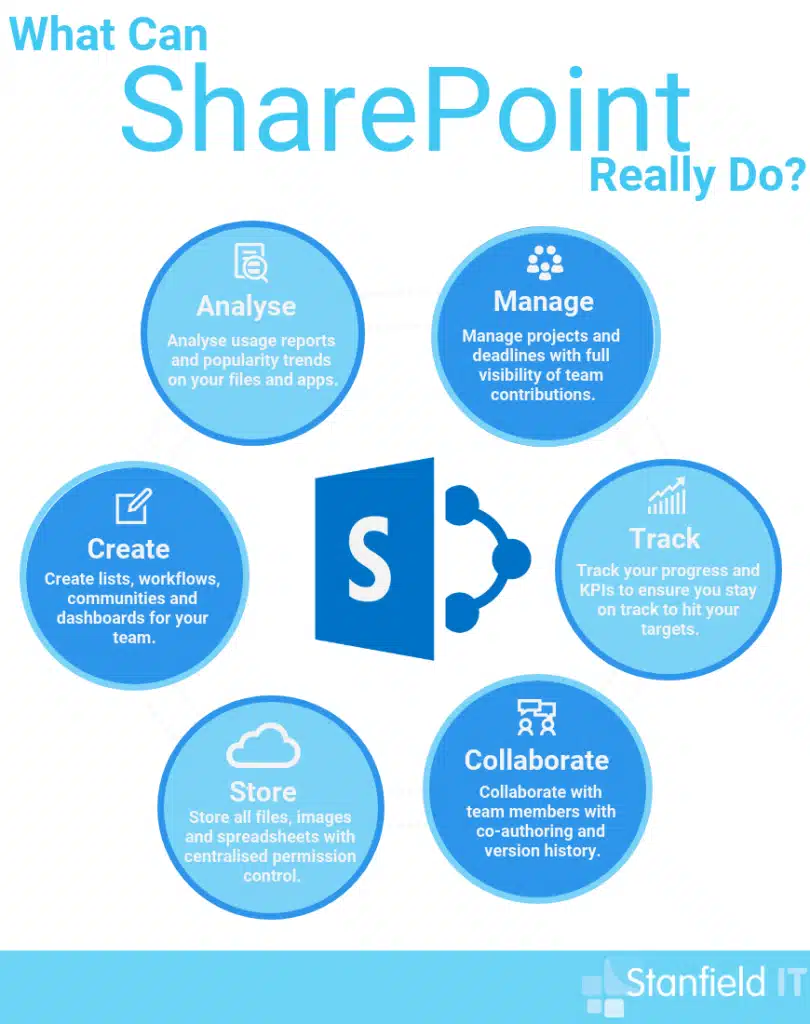
SharePoint allows you to customise what metadata entries you want to tag your files with. There are nearly 30 predefined metadata entries you can choose to sort by, but the most powerful function here is the ability to create your own custom metadata entries. Consider creating metadata entries like status, office location, or document type (e.g. invoices, minutes, proposal, quotes, etc). The only catch is that you will need to consistently tag your files with the relevant categories in order for SharePoint to be able to sort and find files using those tags. You also have the choice to make these metadata columns globally accessible across the site, or local to a single library.
By now you’re hopefully starting to get a better idea of what SharePoint is and what it can do. It’s a multi-faceted tool that integrates into your business and works in conjunction with the rest of your Office 365 suite.
Sharepoint in 2020
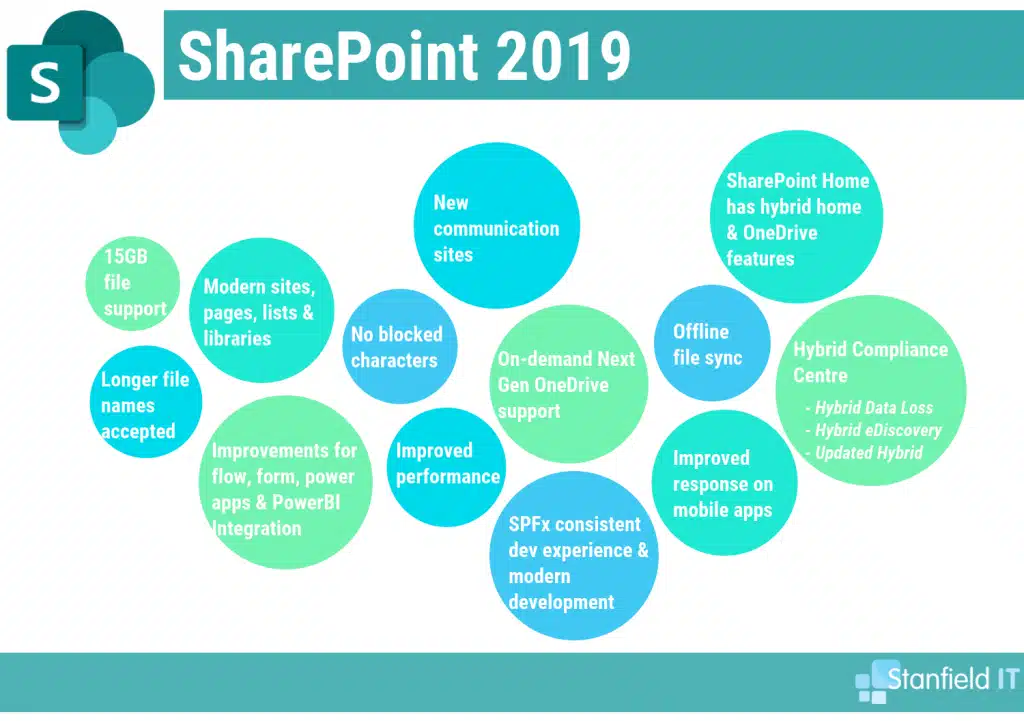
2019 was a fantastic year for SharePoint, with organising, sharing, and locating documents being easier than ever for your employees. This means that you won’t just see a more productive workplace, but a less stressed team, too. If you aren’t using SharePoint to manage and share documents yet, maybe the new features we saw from Microsoft will persuade you to come on board.
The latest edition of SharePoint is called SharePoint 2019. The most substantial changes that came with this SharePoint iteration have been put in place to improve the experience for both on-premises and hybrid users. It may come as a surprise, but a study last year concluded that over half of organisations are, in some capacity, running on-premises environments. That’s why Microsoft’s SharePoint is still ensuring it caters to businesses who operate in on-premises scenarios.
SharePoint Examples—new features for 2019
SharePoint 2019 brings with it a fresh, modern design and has been made to work across any screen. This includes desktops, mobile phones, laptops, or desktops. It’s also an even easier-to-use interface, with the aim to help users optimise their time so that there’s a focus on productivity as opposed to searching for content. Additionally, SharePoint’s new iteration includes many additions that users felt that SharePoint 2016 lacked. Let’s take a look at some of the best new features.
Modern User Experience Improvements
SharePoint 2019 has seen the introduction of UX enhancements that align with the unique experience of SharePoint Online. These changes include enhanced communication capabilities and a push for streamlined collaborative features. Here’s a breakdown of these new-and-improved features:
SharePoint Home
Combining all the sites and news important to your day-to-day in one central dashboard, the new SharePoint home screen is an exciting enhancement that mimics Office 365.
Modern team and communication sites
If you already use SharePoint, this may be one of the most sought-after features you hoped for.
Lists and libraries
SharePoint 2019 offers modern lists and libraries, perfect for intelligently organising files and being able to quickly locate what you need.
User-friendly pages, web parts, and authoring
In previous versions of SharePoint, it was easy to make mistakes when creating and editing pages. The user-friendly improvements that have been introduced in SharePoint 2019 eliminates a lot of this potential for human error. It’s a simple process to create content quickly.
Suite Navigation and App Launcher
The Office 365 “waffle” menu that everyone loves is now available for SharePoint.
Simplified sharing experience
Say goodbye to only being able to give external users access to your SharePoint via a SharePoint license or anonymous access. The flexible sharing capabilities offered in Office 365 are available to you.
Team Site Improvements
Easily integrate your Office 365 group content, SharePoint team sites and Microsoft Teams with the new team site additions. You don’t need to spend the time making new teams; you can connect an existing SharePoint team site to a new group in Office 365. This allows access to the group calendar, shared document library, and planner to manage tasks. If you’d like, you can also add a team in Microsoft Teams as a space for teamwork. Lastly, you can access and share SharePoint pages and news articles (as opposed to just documents) stored in SharePoint libraries.
Communication Site Improvements
SharePoint 2019 comes with new and improved communication sites that intelligently use SharePoint web parts to pull content from Office 365. These new web part make the process of creating and sharing important updates and announcements much easier. Examples are these web parts are Twitter, File Viewer, Ground Calendar, Microsoft Forms, and Planner.
OneDrive
Does your business have a large on-premises library? You’ll be happy to find out that the OneDrive Sync Client for SharePoint 2019 has been much improved from its predecessor. The new push notifications allow for a fast, reliable experience when syncing. Features of OneDrive previously available in the Cloud are now accessible to users in hybrid environments.
Improved Support for Business Processes
SharePoint gives businesses the tools for collaboration, customised business applications, and the automation of business processes. You can expect to say goodbye to the havoc that can ensue when moving complex workloads to the Cloud, thanks to process automation and forms technologies like PowerApps and Flow to connect with your on-premises data.
Administration/Infrastructure Improvements
A lot of the changes Microsoft have introduced in the SharePoint 2019 iteration aim at improving administration and infrastructure. These include:
Direct links to SharePoint documentation
Sick of spending too much time searching for your documents? Well, that’s all over! Instead, use direct go-to links in Central Administration and be directed to what you need right away.
SMTP authentication for sending emails
Send your emails using an actual authenticated SMTP—this includes Office 365 mail.
Workflow Manager 2019
With workflows here to stay, you’ll be happy to know that the new workflows manager takes the place of Workflow Manager 1.0 and offers enhanced features.
Integration with PowerApps and Flow
Deeper integrations with Flow and PowerApps means you can enjoy better performance and fewer restrictions.
Hybrid Environments
Microsoft have made a point of building on SharePoint’s prior features to make it even easier to configure and manage in hybrid environments. This includes the Hybrid Status Bar (where you can monitor your hybrid configuration in one view) and Holistic search.
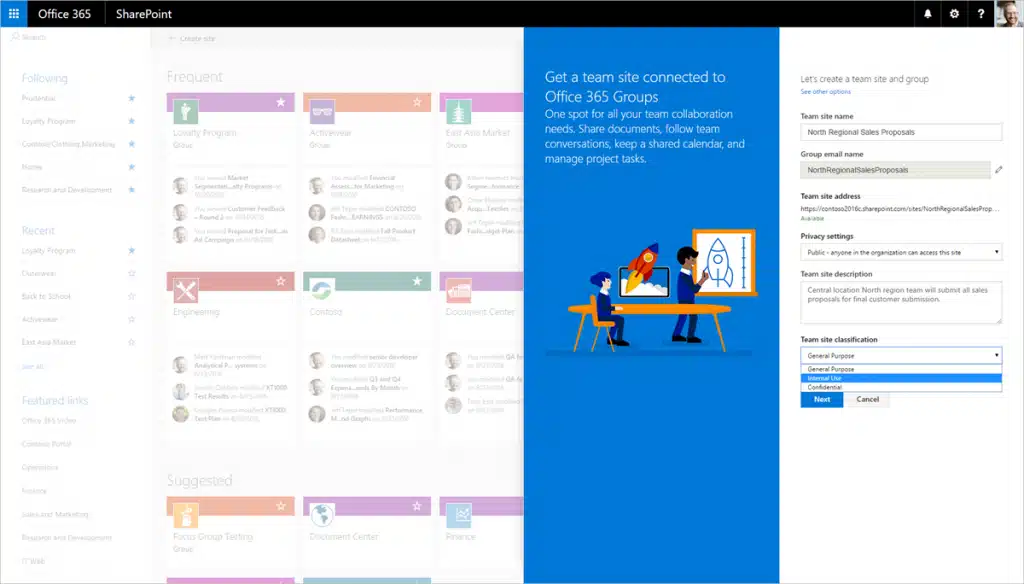
SharePoint Examples of Use
We mentioned earlier how SharePoint works hand in hand with Microsoft Teams. This partnership is one of many examples of how SharePoint can be used within your business.
As you probably know, Teams is a real-time collaboration tool. It would be easy to just call it an instant messaging tool, but that’s not really the point. If you’ve ever had a group project to work on, you’ve needed a tool like Teams. Instead of emailing back and forth, you communicate in real time with one another. It’s really sounding just like a chat program right about now, but bear with us.
When you create a Team, Microsoft Teams will automatically create a shared site in SharePoint for your group to work on. Everything that you share within your Team channel, is also shared to your SharePoint site automatically so you’ll never need to do that really annoying thing where you scroll tediously back through an old conversation to find that one document or image that was shared. Don’t pretend you haven’t had to do that! This is one of our favourite SharePoint examples to share, to show just how effectively it can work within your (dare we say it?) team.
Sharepoint Permissions
We’ve been rattling on about SharePoint permissions now, without really looking into what we mean. Centralised permission control, inherited permissions. What is the significance? SharePoint permissions sound a little bit complicated, but ultimately it’s a system that makes things much easier for you in the long run.
As a general rule, in any system, no one user has access to everything. That’s more-or-less restricted to IT admins or perhaps a company-wide director. Enabling different sets of permissions isn’t just about hiding sensitive information from certain employees either, though it can certainly be used in that way. It’s about eliminating superfluous information.
John in Marketing doesn’t need access to accounting reports. If he wants to find something in SharePoint, eliminating the irrelevant results makes his job much easier. In a way, this is what permissions is doing.
What is Permissions Inheritance?
SharePoint works as a hierarchical system. Each site exists within a site collection, which is a group of sites under a top-level site (the root site). Every created site inherits the permission settings of the root site. Following this pattern, lists and libraries inherit the permissions from the site that they belong to.
If you are the site owner, you can change the permission settings for the site, and you can change the permission settings for the list or library. If you have control of a list or library, you can also stop permissions inheritance for a specific item (this is called object-level permission).
Centralised Permission Control
To understand what we mean by centralised permission control, we need to cover how permission levels are assigned to users. A SharePoint group is a set of users who all have the same permission level. Every SharePoint team site automatically has three groups (Owners, Members and Visitors). These groups can create/edit, contribute, or read-only, in that order.
If you’re using something like OneDrive, you have to assign permissions individually. You have to go to your file, and manually share access with every single user. If you need to share with a larger number of people, this gets tedious very quickly. And if you need to change or revoke access later on, it becomes complicated to keep track of who has access to what file.
Using these SharePoint groups means you can quickly and conveniently assign the same permission level to multiple users. Everything they can access is contained within the same library or site. If you need to revoke access, you don’t need to mess with every single file. You can just remove that user from the group. Voila! Centralised control. It makes things much easier.
SharePoint Designer
Let’s cover one last feature before we wrap this up. We ummed and ahhed over including this tool, but ultimately felt it’s still worth a mention. SharePoint Designer is a program designed to customise SharePoint sites and applications. There’s a big but, though. SharePoint Designer was discontinued by Microsoft after the 2013 edition.
You can still download and access SharePoint Designer 2013, and it is still currently supported (keyword currently), and yes you can use it with SharePoint Online. However, as it has been discontinued, it does seem likely that Microsoft will gradually stop supporting it until its phased out altogether.
To briefly touch on what SharePoint Designer actually does though: it’s an HTML editor tool that allows users to create SharePoint solutions from web publishing, to data integration, further granular control over site objects, and customising your workflows. With this tool possibly on its way out, however, Microsoft experts are suggesting PowerApps, and Flow as tools that fit in this vacated space.
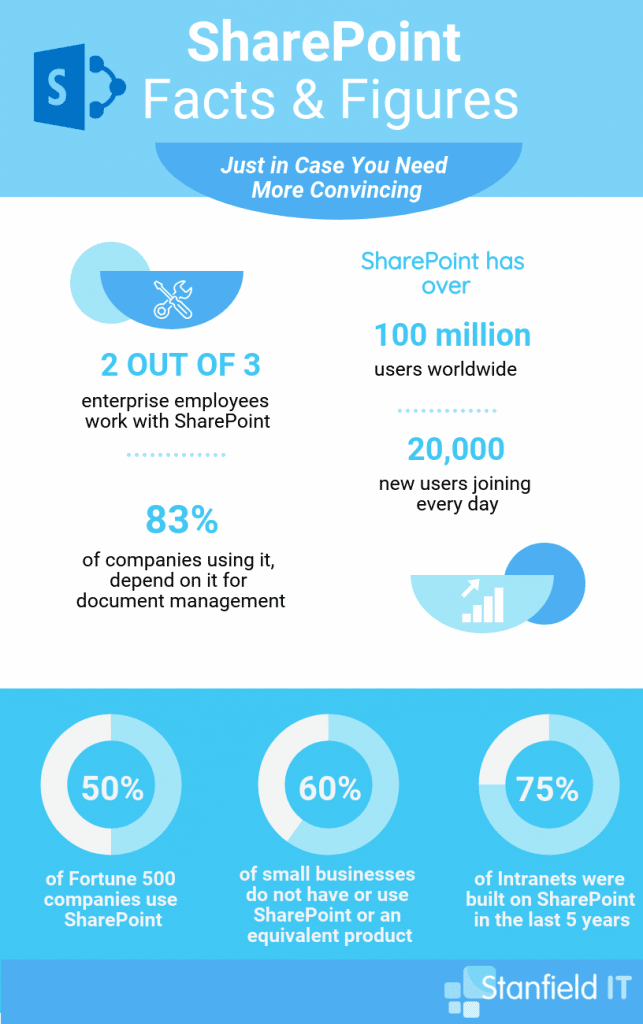
Moving to SharePoint?
Given that SharePoint was previously an on-premise server tool, it stands to reason that it generally just utilised by large enterprises who had the means (and budget) to install such a large-scale product. However, with SharePoint Online now, it’s far more accessible to your average local business.
SharePoint is now included with your Office 365 subscription, so there’s no already no additional commitment required. It’s right there. However, maybe you’re one of those enterprises who previously implemented an on-premised SharePoint server. Either way, implementing SharePoint, or migrating to the new system; this move can only empower your business.
It can be a daunting step, especially migrating existing data to a new system, but Stanfield IT is happy to chat with you about what you need and how a project like this can come to life.
